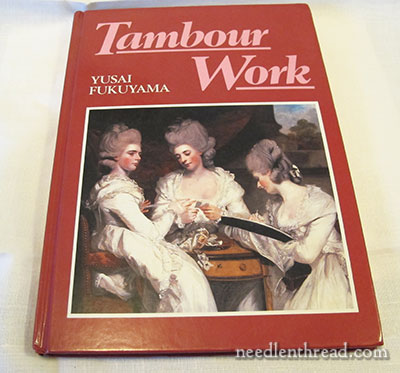Today, most of the current, in-print books that focus on work with the tambour needle are beading books. Occasionally, these books will have a chapter or a section on tambour embroidery, but for the most part, they focus on work with beads and sequins.
That’s ok! You can learn a lot about tambour embroidery from these books, too. I’m not knocking them – I’m just stating a fact. They’re mostly books on beading.
But if you want what I think is the best and most thorough book on all aspects of tambour work, primarily focusing on embroidery, you’ll have to scour libraries and out-of-print, used book sources for it.
The book is Tambour Work, by Yusai Fukuyama, published in 1987 by Dryad Press in the UK.

I first bought this book some 10 years ago, when I bought my first tambour needle. But at the time, I never did anything with either, beyond a brief dabble.
This book is not a huge tome. It’s not elaborate. It’s not complex. It’s a very simple, very clearly written and illustrated book on how to use the tambour needle primarily for embroidery. It is truly an instructive book, more than a picturesque book.

The book is completely printed in black and white – there’s not a lick of color in it – but don’t let that deter you!
The author begins with an explanation of the equipment used for tambour work. He shows a variety of different types of hoops and frames that can be used, and even gives some substitutions if you don’t have any of them.

Using very clear line drawings, he demonstrates the set-up for working with a tambour needle, how to hold the needle, what to do with your thread, and so forth.

Again, with line drawings, he illustrates and explains the movements involved in tambour embroidery. He includes all the pertinent details of starting and ending threads, of inserting the hook, wrapping the thread, turning the hook, removing the hook – everything you need to know to successfully maneuver the tambour hook is here.

He covers any of those little difficult moves, too, like turning a sharp corner.

Then, he presents different shapes or elements, and demonstrates how these would be embroidered – he illustrates the path of the chain stitched lines, where they should start and end, and what the element should look like when complete.

These pages are priceless for one who wishes to learn to fill shapes with tambour embroidery in a way that makes sense and looks nice.

Besides leaf shapes, he covers fruit shapes…

…and flowers.
These are perfect for practice! I love how he shows start and stop points, directions of stitching, turning points, and so forth, for each element. It’s as if the author anticipated the beginner’s every quandary, and took each into consideration when preparing the book.

In the instructional area, there’s a little blurb on beading, and a few samples for beading and sequin work.
There’s also a little section on couching with tambour work.

The second part of the book is devoted to tambour lace – the embroidering of machine-made nets with a tambour hook. Though specifically focusing on lace here, much of the information can apply as well to tambour embroidery on regular fabric.

There are some differences, though. For example, starting and securing the threads is slightly different, so he points out the best way to accomplish starts and ends when working on net.

And then, the practice motifs are pretty much the same layout as in the embroidery section. Line drawings are given, with clear starts and stops, with the stitching path marked, and a finished sample is shown.

There are all kinds of nice lace designs here, which could also translate into surface embroidery designs.
At the end of the book, Yusai Fukuyama provides a list of suppliers around the world, too, but unfortunately, many of them are now defunct.
Where to Buy Tambour Work
You can find Tambour Work by Yusai Fukuyama through the following used sources:
Tambour Workon Amazon in the US – there were a few “less expensive” copies available earlier, but I’m not sure what they’re running now.
Tambour Work at Amazon UK – again, I’m not sure what they’re running now.
Tambour Work at Amazon in Canada – they actually had some good prices on the book a few weeks ago, but they’ve climbed since.
Tambour Work at AbeBooks – they had some of the lowest prices (just over $20) a few weeks ago, but they’ve jumped a bit.
Check eBay as well. Right now, the one listed is too expensive, in my opinion, but you never know if someone will list it again soon.
Possible Alternative
You can also try looking for Tambour Work: 80 Patterns for Lacemakers and Embroiderers by Yusai Fukuyama. I’m not sure if it’s the same book or not, but I suspect it is. It was published in 1997 with a different cover, but the description sounds the same. It’s also quite pricey through used book sources, but Blackwell’s in the UK carries it for a relatively reasonable price. It does not ship immediately, though.
Check Your Library!
Finally, before squandering large funds on the book, do check your library! If they don’t have it, see if they can get it for you through interlibrary loan.
Books like this also turn up at library book sales and in thrift stores (or “op shops”) for practically nothing. I’ve bought books at library book sales for twenty-five cents that are going for $100+ through used book sources online. If your nearest large city has a large library, find out when they have their library book sales and make plans to attend. There’s usually a cover charge to get in on the first opening, but oh, the bargains you’ll find!
